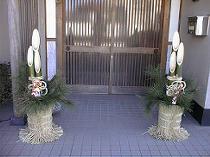|
Êadomatsu. The New
Year's decoration in Japanese
 New Year's Day is designated as one of the
national holidays in Japan to celebrate the beginning of the New Year.
This day is so important in Japan, because we make a fresh start with
wishes for happiness and prosperity throughout the New Year. The
Japanese attach a particular importance to the beginning of a year,
because a Japanese proverb says, "New Year's Day is the time to make
plans for the coming year." Originally the New Year was celebrated
to invite the god of the year. New Year's Day is designated as one of the
national holidays in Japan to celebrate the beginning of the New Year.
This day is so important in Japan, because we make a fresh start with
wishes for happiness and prosperity throughout the New Year. The
Japanese attach a particular importance to the beginning of a year,
because a Japanese proverb says, "New Year's Day is the time to make
plans for the coming year." Originally the New Year was celebrated
to invite the god of the year.

This
very characteristic photograph of Kadomatsu belongs to TEMARI, Center
for Asian and Pacific Arts.*
|
So we have the New Year's decoration for
inviting the god of the year. We set it up to welcome our ancestral
spirits as well. It is set up on either or both sides of the front
entrance of the house. it comprises pine boughs, bamboo stalks and plum-tree
sprigs. This is the so-called kadomatsu or the New Year's decoration in
Japanese. It is regarded as the residence of the god of the year. You
may see the simple new Year's decoration made of only pine branches
wrapped with the Japanese paper, which is hung in the center at the top
of the house gate. Officially the New year's decoration consists of
three bamboo poles with different sizes respectively which are cut
diagonally. Plum-tree sprigs, pine boughs and bamboo stalks are combined
with the bamboo poles set in the center. They are wrapped with straw
mats and tied with the new straw ropes. We set up this New Year's
decoration outside homes with the hope that the new year will bring
longevity, prosperity and constancy to each member of the family. A
majestic evergreen pine tree grows into a tall, towering tree, so it is
used as a symbol of longevity. Bamboo is a very strong plant that grows
very straight and tall with a sturdy root structure, so it is thought of
as a symbol of prosperity. The plum tree is not only neat and clean but
also withstands the cold patiently and constantly, so it is considered
to be a symbol of constancy.
*TEMARI, Center
for Asian and Pacific Arts is non-profit organization. Their Mission is to perpetuate traditional Asian and Pacific culture and
encourage the creation of contemporary artforms through educational programs,
exhibitions and public events.
|
